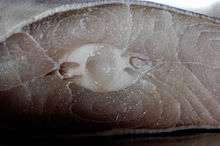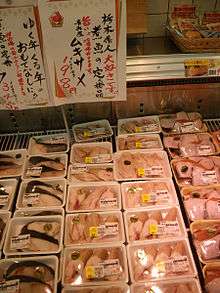Shark meat


.jpg)
Shark meat is a seafood consisting of the flesh of sharks. Its consumption by humans has been mentioned since fourth century AD literature.[1] Several sharks are fished for human consumption, such as porbeagles, shortfin mako shark, requiem shark, and thresher shark, among others.[1] Shark meat is popular in Asia, where it is often consumed dried, smoked, or salted.[2] Shark meat is consumed regularly in Japan, India, Sri Lanka, areas of Africa and Mexico.[2] In western cultures, shark meat is sometimes considered as an inferior food, although its popularity has increased in Western countries.[2]
Preparation
Unprocessed shark meat may have a strong odor of ammonia, due to the high urea content that develops as the fish decomposes.[3] The urea content and ammonia odor can be reduced by marinating the meat in liquids such as lemon juice, vinegar, milk, or saltwater.[4] Preparation methods include slicing the meat into steaks and fillets.[1]
Africa
In Eastern Africa and islands in the Indian Ocean, shark meat has been traded and has been a significant source of protein for centuries.[1] Its consumption may occur primarily in coastal areas. It may be preserved using salt curing to extend its shelf life and to enable easier transportation.[1]
Asia
Shark meat is common and popular in Asia.[2] In 1999, the combined countries of Asia led in the number of sharks caught.[1] Asian fisheries harvested 55.4% of the world's shark catch in 1996.[1]
Japan
Japan has a large market share in the trade of frozen and fresh shark meat, for both importation and exportation.[1] Shark meat is typically consumed in prepared forms in Japan, such as in prepared fish sausage, surimi, fish paste, fish balls, and other products.[1]
Korea

In Korea, dombaegi (돔배기), salted shark meat, is eaten in North Gyeongsang Province.
Australia
Shark meat is popular in Australia, where it is known as flake. Flake is sourced primarily from gummy shark, a small, bottom-feeding species abundant along the east coast of Australia. Flake can be purchased as a ready-made meal from most Australian fish and chip shops, usually in the form of battered or grilled fillets.[5]
Europe
Per the Food and Agriculture Organization of the United Nations (FAO), European countries are major markets for shark meat.[1] Pickled dogfish is popular food in Germany, France, and other northern European countries.[1] The meat is typically processed and consumed in steaks and fillets.[1] In Germany, though, a preference exists for backs, belly, and smoked belly flaps, which are referred to as Schillerlocken.[1] Per the FAO, Italy led globally in the importation of shark meat in 1999, with France and Spain following.[1] In 1999, France imported the second-largest amount of shark meat on a global level.[1]
Iceland
In Iceland, hákarl is a national dish prepared using Greenland shark[6] or sleeper shark. The shark meat is buried and fermented to cure it, and then hung to dry for several months.[6]
See also
References
| Wikimedia Commons has media related to Shark (food). |
- 1 2 3 4 5 6 7 8 9 10 11 12 13 14 15 Vannuccini, S. (1999). Shark Utilization, Marketing, and Trade. FAO fisheries technical paper. Food and Agriculture Organization of the United Nations. pp. 66–93. ISBN 978-92-5-104361-5.
- 1 2 3 4 Carwardine, M. (2004). Shark. Firefly Books. p. PT 126. ISBN 978-1-55297-948-8.
- ↑ Kim, S.K. (2014). Seafood Processing By-Products: Trends and Applications. SpringerLink : Bücher. Springer. p. 30. ISBN 978-1-4614-9590-1.
- ↑ Bashline, Sylvia (January 1980). "Eating Shark - Instead of Vice Versa". Field & Stream. p. 46. Retrieved 26 August 2015.
- ↑ John Ford, Robert Day: "Flake is sustainable gummy shark, except when it’s not". The Conversation. May 1, 2015.
- 1 2 Deutsch, J.; Murakhver, N. (2012). They Eat That?: A Cultural Encyclopedia of Weird and Exotic Food from around the World. ABC-CLIO. pp. 91–92. ISBN 978-0-313-38059-4.

